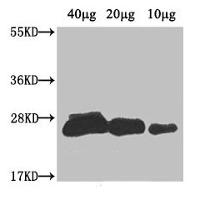1

Anti-Osmotin
AS19 4336 | Clonality: Polyclonal | Host: Rabbit | Reactivity: Nicotiana tabacum
- Product Info
-
Immunogen: Recombinant Osmotin derived from Nicotiana tabacum protein sequence, amino acids: 22-246. UniProt: P14170
Host: Rabbit Clonality: Polyclonal Purity: >95%, Protein G purified to a total immunoglobulin G fraction. Format: Liquid Quantity: 50 µg Storage: Store at -20°C or -80°C, avoid repeated freeze-thaw cycles. Make aliquots to avoid repeated freeze-thaw cycles. Please remember to spin the tubes briefly prior to opening them to avoid any losses that might occur from material adhering to the cap or sides of the tube. Tested applications: ELISA (ELISA), Western blot (WB) Recommended dilution: 1 : 500 - 1: 1000 (WB) Expected | apparent MW: 26 | 27 kDa - Reactivity
-
Confirmed reactivity: Nicotiana tabacum Predicted reactivity: Capsicum annuum, Solanum lycopersicum
Species of your interest not listed? Contact usNot reactive in: No confirmed exceptions from predicted reactivity are currently known - Application Examples
-
application example

Varied amounts of recombinant Nicotiana tabacum osmotin were loaded/well and separated on 10 % SDS-PAGE and blotted 1h to PVDF using semi-dry transfer. Blot was blocked with 5 % milk for 2h/RT with agitation. Blot was incubated in the primary antibody at 3 µg/ml for 1h/RT with agitation in PBS-T. The antibody solution was decanted and the blot was rinsed briefly twice, then washed 4x in PBS-T at RT with agitation. Blot was incubated in matching secondary antibody (anti-rabbit IgG horse radish peroxidase conjugated) diluted to 1:50 000 in for 1h/RT with agitation. The blot was washed as above and developed with chemiluminescent detection reagent according to manufacture's instructions.
- Additional Information
-
Additional information: Preservative: 0.03% Proclin 300. Preparation contains: 50% Glycerol, 10 mM PBS, pH 7.4
Reactivity of this antibody on endogenous sample remains to be determined. - Background
-
Background: Osmotin protein (from thaumatin protein family), coded by a gene AP24. Known to inhibit the germination and growth of the fungus Phytophthora infestans. Protein is induced by: salt stress, ABA viral infection and wounding. Localised to vacuole. - Protocols
-
Agrisera Western Blot protocol and video tutorials
Protocols to work with plant and algal protein extracts
Agrisera Educational Poster Collection - Reviews:
-
This product doesn't have any reviews.
Accessories

AS07 213 | Clonality: Polyclonal | Host: Rabbit | Reactivity: Higher plants including A.comosus, A.thaliana, C.sativus, C. australis R.Br, C.reinhardtii, F. margarita Swingle, H.vulgare, L.esculentum, L.longiflorum, Malus x domestica Borkh. c.v. Fuji, M. truncatula, M.crystallinum, N.tabacum, N.caerulescens, O.sativa, P.hybrida cv. Mitchell, Populus sp., P.vittata, Thellungiella sp., T. aestivum, Z.mays, V. vinifera | Cellular [compartment marker] of tonoplast membrane

AS07 256 | Clonality: Polyclonal | Host: Rabbit | A.thaliana, P. tremula, L. esculentum, G. max, N. tabaccum

